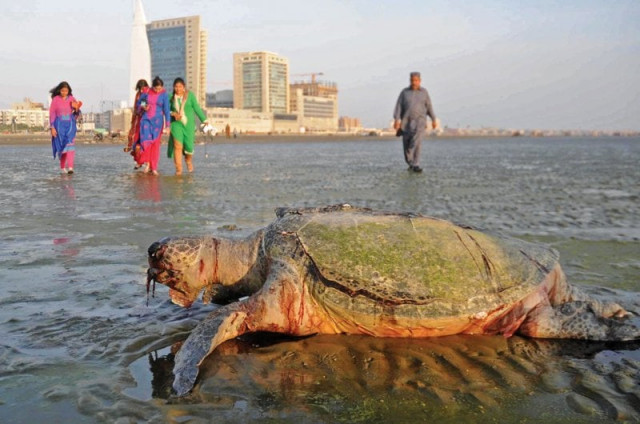
A group of fishermen caught a 45-centimetre long, male leatherback turtle in their fishing net. They brought it to Gwadar Fish Harbour and released it after a few hours into the deep sea with the help of the World Wide Fund for Nature — Pakistan (WWF-P) and the Balochistan Coastal Development Authority.
This was the fifth occasion that a leatherback turtle was found in Pakistan’s waters, following the ones found in 1988 and 1989 in Karachi, and in 2002 and 2013 in Gwadar. The first three turtles were found dead.

In Pakistan, five main species of marine turtles have been reported to exist. These include the green turtle, Olive-Ridley turtle, hawksbill turtle, loggerhead turtle and leatherback turtle. All of these, except the green turtle species, are considered rare.
“It was about 15 years old and five-feet long with an estimated weight of above 200 kilogrammes,” said the technical adviser for WWF-Pakistan, Muhammad Moazzam Khan.
According to a 45-year-old fisherman, Lal Bux, it was a rare incidence as these turtles are hardly caught in fishing nets. “When the turtle got entangled in our fishing net, we figured it was a rare species,” said Bux. “We sacrificed the net and saved the turtle.”
Leatherback turtles are a rare reptile species. According to Khan, their estimated population in 1982 across the world was around 115,000. The number had gone down to only 40,000 by 1996. “Its population in Indian Ocean has declined drastically in the last 40 years,” said Khan. “Their population in the nesting colony at Terengganu, Malaysia, went from more than 3,000 females in 1968 to 20 in 1993 and to only two recorded recently.”
WWF-P director Rab Nawaz believes that the coast of Sindh and Balochistan harbours a large number of jellyfish, which is the main source of diet of the leatherback turtles. The abundance of jellyfish might be the reason that the rare reptiles are being attracted to the coast, he said.
“The number of jellyfish has increased significantly along the coast of Sindh and Balochistan during the past 10 years,’ he said. “The WWF-P is planning to conduct further research on this [turtle] specie.” He added that his organisation is also taking conservation steps for the protection of marine biodiversity in Pakistani waters.
“Releasing the turtle alive is a good omen for the country’s biodiversity,” said Nawaz. He stressed the need for all stakeholders, including fishermen, wildlife department and non-governmental organisations, to take necessary steps for the protection of these rare turtles. He called for measures such as monitoring nesting beaches and patrolling them to protect female turtles from scavengers such as feral dogs.
According to the WWF-P officials, the leatherback is the largest marine turtle. It is mostly found in the Indian and Pacific oceans, including the North Sea. In the Arabian Sea, it is found in the waters of India, Oman, United Arab Emirates and Yemen but remains the rarest of all turtle species in the area. The leatherback can weigh as much as 900 kilogrammes and has a teardrop-shaped body.
Nawaz regretted that the leatherback turtles, who have survived for more than a hundred million years, are now facing extinction.
Published in The Express Tribune, January 8th, 2015.


















COMMENTS
Comments are moderated and generally will be posted if they are on-topic and not abusive.
For more information, please see our Comments FAQ